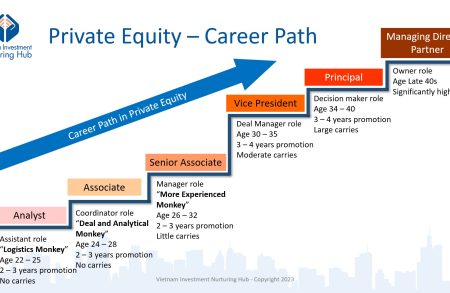23Jul
In the dynamic world of Private Equity (PE) and Investment Banking (IB), success isn’t just about spotting opportunities. It’s about meticulously understanding them, quantifying their potential, and de-risking every decision. At the heart of this critical process lies the financial model: a dynamic projection that transforms raw data into strategic insights. It’s the compass guiding multi-million dollar investments, the blueprint for complex deals, and often, the ultimate determinant of a transaction’s fate.
But not all financial models are created equal. A poorly constructed model can lead to catastrophic misjudgments, while a robust, reliable one empowers confident, value-generating decisions. Here at Vietnam Investment Nurturing Hub, we believe that mastering financial modeling isn’t just a skill – it’s a superpower. Based on our extensive experience working with a large range of firms, we’ve identified 8 non-negotiable requirements for building financial models that truly stand out and deliver. If you’re involved in M&A, valuations, fundraising, or portfolio management, understanding these pillars isn’t optional – it’s essential for navigating the complexities and seizing the opportunities that define PE and IB.
Well-Structured and Professionally Formatted Model
Imagine walking into a crucial client meeting with a disorganized, cluttered document. Not only would it be hard to follow, but it would also instantly erode confidence. The same applies to your financial model. A well-structured and professionally formatted model isn’t just aesthetically pleasing; it’s a fundamental requirement for clarity, collaboration, and credibility. In fast-paced environments, stakeholders – from deal partners and investors (Limited Partners in PE) to clients and senior management – need to quickly grasp the essence of the deal analysis. A chaotic model leads to confusion, errors, and wasted time.
To achieve a well-structured model, we always adopt a modular structure, a well-organized layout, consistent color coding, and particularly a presentation-ready Dashboard. We believe that the model isn’t just presenting numbers; it’s presenting a meticulously crafted analysis.
Accuracy and Reliability
A financial model, no matter how beautifully structured, is useless if its outputs are unreliable. Accuracy is paramount. In PE and IB, decisions involving hundreds of millions, even billions, of dollars are based on these models. An error, however small, can have monumental consequences. As a result, inaccurate models lead to flawed valuations, misguided investment decisions, missed opportunities, and severe reputational damage. Reliability builds confidence and allows for decisive action. We ensure accuracy and reliability by using verified, up-to-date financial data from reliable sources, adopting robust error-checking mechanisms, and conducting thorough output cross-checking processes.
Flexibility and Scalability
The world of finance is rarely static. Economic conditions shift, business strategies evolve, and new information emerges. Your financial model must be a dynamic tool, not a rigid report. It needs to flex and scale with changing circumstances. A flexible model allows us to quickly assess the impact of new assumptions, run multiple scenarios, and adapt to evolving deal terms without rebuilding from scratch. Scalability means it can grow with the complexity of your analysis, such as adding new business segments or changing deal terms. Flexibility and scalability are achieved through modular design, an inter-related structure, and an assumption-driven dashboard that incorporates dynamic inputs.
Clarity and Transparency
A financial model should never be a black box. If someone else cannot easily understand the logic, trace the calculations, and identify the source of numbers, it significantly diminishes its value. Transparency builds trust and facilitates collaboration. In complex PE and IB deals, multiple parties (legal, tax, operations, senior management) need to understand the financial implications. A transparent model allows for efficient review, reduces disputes, and ensures everyone is on the same page. Clarity and transparency are built on the basis of full historical data integration, logical flow, and clear documentation.
Comprehensive Outputs
A financial model isn’t just about the three financial statements. To be truly valuable in PE and IB, it must generate a full suite of comprehensive outputs that directly inform investment and deal-making decisions. In PE and IB, generic outputs simply won’t work, as stakeholders need a holistic picture of financial performance, risks, and returns, tailored to the specific context of PE or IB transactions. The comprehensive outputs of a PE/IB model should include three fully integrated statements (Income Statement, Balance Sheet, Cash Flow), backed by a number of working statements (CapEx, Working Capital, Debt, etc.), a valuation statement, risk analysis, and an investment performance statement with different exit options. These outputs should also produce key financial and operational metrics for analysis and decision-making.
Risk Assessment
Financial models are not just about projecting the upside; they are equally about understanding and quantifying the downside. Robust risk assessment is crucial for informed decision-making and protecting capital. Identifying and quantifying risks allows investors and bankers to make prudent decisions, structure deals more effectively, and prepare contingency plans. PE and IB models should allow the analyst to conduct risk analysis via sensitivity analysis, scenario analysis with stress testing, and breakeven analysis.
Alignment with Purpose
A generic model won’t resonate with the specific objectives and stakeholder requirements of PE or IB. While many core principles apply universally, the specific emphasis and outputs of a financial model differ significantly between Private Equity and Investment Banking. A truly effective model is purpose-built. Tailoring the model ensures it directly addresses the questions and concerns relevant to each domain. Private Equity-focused models emphasize the operational and financial drivers, value-creation process, and cash flow control. Investment Banking models focus more on valuation, deal structuring, synergies, accretion and dilution effects, and deal-specific features.
Efficiency and Performance
In today’s fast-paced financial landscape, time is money. A clunky, slow-running model is a productivity killer and a source of frustration. Efficiency ensures the model is a tool that enhances, rather than hinders, workflow. An inefficient model leads to long construction and review times, increased frustration, and a higher probability of errors as users try to work around its limitations. A lean, high-performing model allows for rapid iteration and analysis. To avoid overcomplication, we should keep the model as simple as possible while capturing all necessary details. Resist the urge to add unnecessary complexity that slows it down or introduces errors. Every calculation should have a clear purpose. Additionally, best practices in using spreadsheets (like Excel) for building models also help make them leaner and more efficient.











